Sewerage in a private house: overview of arrangement options + step-by-step guide
It's hard to imagine a country cottage without a civilized toilet and a cozy bathroom.But not every village is equipped with a waste collection system. That's why, sewerage in a private house performed separately. Don't know which system to choose? This article will tell you about all the features of sewerage in a private house.
We described possible ways to organize waste collection, outlined their design and application features. They also provided step-by-step instructions on drawing up a project, installing a sewer pipeline, installing a septic tank and a drainage well.
The content of the article:
Types of sewerage systems
There are several types of waste collection systems: central, storage, drainage, filtration.
Central. The house's waste pipe is connected to the general sewer network, through which organic waste is collected in the city sewer.
Next, the wastewater is filtered, going through several stages of purification, and the already safe water ends up in the local reservoir. The homeowner pays money monthly for use.

Accumulation system – modern prototype cesspool. The main difference is the complete sealing of the waste collection point. It can be: concrete, brick, metal, plastic. To do this, a ditch for the container is dug on a plot of land remote from the residential building.
The principle of operation of the storage system is reduced to the discharge of organic compounds into a sealed container. When it is full, the contents are pumped out sewage treatment plant by car.
This scheme for installing an individual sewer system in a private house has gained wide popularity due to its low cost.
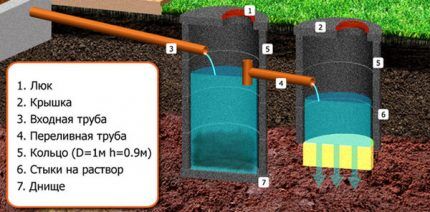
Draining septic tank The waste collection process is similar to a storage tank. The only difference is the absence of the bottom of the container. This allows settled water to go into the ground through the drainage pad. The drainage well is made of concrete or red brick.
Filtration units installed in areas with high water consumption. The entire system has from 1 to 4 tanks located underground. The first three tanks are used to collect and sequentially clean organic matter. The last container does the final cleaning.
In fact, the filtration installation combines elements of the three previous types of sewerage. Depending on the manufacturer, the installation elements are equipped with different cleaning systems to take into account local conditions.
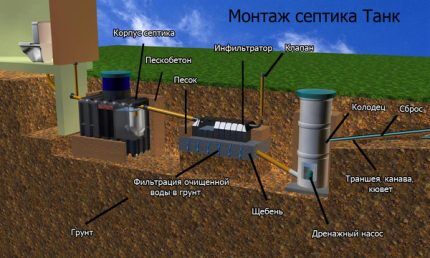
If you are building a country house and are puzzling over how to install a sewer system, we suggest you familiarize yourself with the stages of installing the most effective and affordable system - a septic tank with a drainage well.
Stages of arranging a wastewater system
Before installing sewerage in a private house, you need to make a project. It includes a working drawing, which indicates the dimensions of the plot and marks the boundaries of the residential building and adjacent buildings. After this, a septic tank is located, taking into account the rules of the neighborhood.
Sewage installation work includes the following stages:
- Planning the sewer system.
- Installation of a pipeline in the premises of the house with outlet to a single drain.
- Construction of a collection tank for organic waste with a drainage well.
- Laying a central pipe from the house to the tank.
If you plan to install a sealed tank, the last step is eliminated.
Stage No. 1 - drafting
There are several determining factors, the analysis of which allows you to select a suitable sewer system: soil type, topography of a suburban area, volume of water consumption, groundwater level, neighborhood, location of residential and commercial buildings, availability of a well with clean water.
Let's look at each point in more detail.
We take into account the type of soil and relief
Each type of soil has individual characteristics.
What to pay attention to:
- heaving;
- freezing depth;
- humidity;
- degree of moisture absorption.
The type of soil is important for the drainage system. For example, clay does not allow moisture to pass through very well. But black soil, on the contrary, is good. This parameter is taken into account when determining the filter surface area.
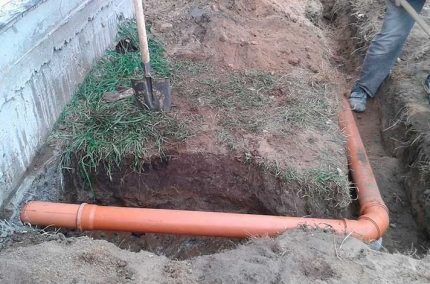
If the house is located on a plot with a broken profile, i.e. There are large differences in the level of the ground surface, the septic tank is located in a lowland.Failure to follow this rule will result in partially contaminated water leaking to the surface. The result is severe wastewater pollution on the site.
We calculate the volume of water consumption
The volume of water consumption is important when arranging an individual sewerage system.
The volume of water consumption is affected by:
- length of time spent in the house - main residence or summer cottage;
- number of people in the family;
- number of floors of the cottage;
- number of household appliances.
To calculate the exact figure, you can refer to reference books and SNIP. Consumption standards are indicated there, calculation formulas and coefficients are given.
In order not to remember the mathematics course, use the online calculator presented on our website. Its calculation algorithm complies with all the rules of current regulatory documents.
For a family of 4 people living on a permanent basis, using a latrine, a bathroom, as well as a washing machine and dishwasher, the daily volume of wastewater is 1 m33.
We take into account groundwater and neighbors
Installation of a drainage septic tank is possible only if there is more than 1 m from the bulk filter pad to the water bed. If this distance is less, organic waste will definitely fall into the aquifer.
The solution to this problem lies in the organization of a sealed septic tank. You will have to spend money on pumping out sewage, but there is no other way out.
An alternative to a holding tank is to install a forced filtration system. This complex is equipped with several levels of cleaning. After a full filtration cycle, the water is suitable for technical needs - irrigation, etc.
Also, before digging a hole for containers, you need to decide on its location. Requirements SanPiN strictly determine the distances to which the septic tank is removed from houses, utility structures, trees, sources of drinking water, as well as reservoirs.
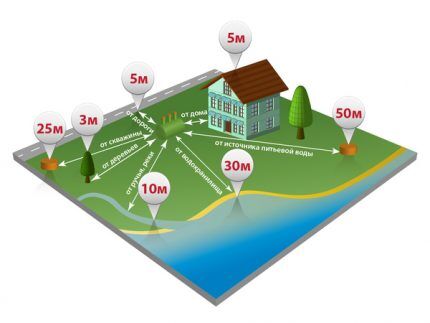
Compliance with these standards is the responsibility of every homeowner. If you violate neighborhood rules, in addition to the fines that you will definitely receive, you can harm your own health.
Stage No. 2 - installation of internal pipeline
Good water drainage, first of all, depends on the design of the internal pipeline of the cottage. After installing the plumbing fittings, it will need to be connected to a single sewer pipe, through which the wastewater will go to treatment basins.
Pipeline installation
First of all, you need to decide pipe type. It is better to purchase products made from polyvinyl chloride (PVC), since cast iron and metal options require welding.
For an inexperienced person, the process of electric welding of cast iron pipes can become a “stumbling block” on the path to a positive result. Cast iron is a brittle metal, and sudden cooling of the butt weld will inevitably lead to the appearance of microcracks.
Plastic pipes have many advantages, including:
- small weight;
- ease of installation;
- affordable price;
- large selection of adapters and bends;
- inertness to aggressive environments;
- durability.
Installation starts from the kitchen. The most distant point, usually the place where the kitchen sink is installed, is located above all subsequent ones.
The last to be connected is the toilet (toilet bowl), the waste pipe of which is located closest to the central drain.
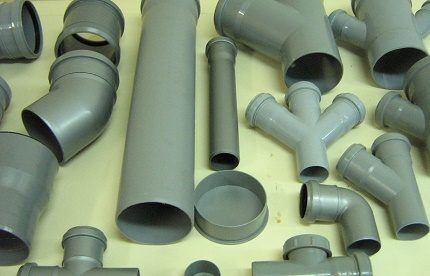
It is advisable to combine the kitchen and bathroom into one riser. To connect all water discharge points, except the toilet, a pipe with a cross-section of 50 mm is used. For the toilet - 110 mm.
The angle of inclination depends on the diameter of the pipe. For 50 mm, the difference in height of two points 1 meter apart is 30 mm. This value is strictly recorded in the regulatory documentation.
With a smaller difference, the water will stagnate. At a higher value, solid fractions will stick to the walls of the pipe, and due to the increased discharge rate, there is a high probability of failure of the nearest water seal.
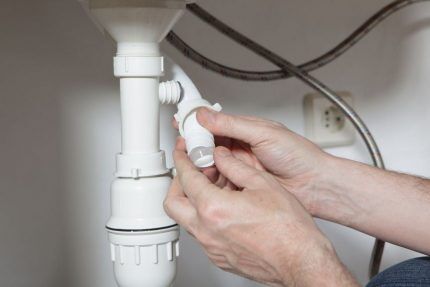
Detailed information about sewerage installation in a private house is presented in this article.
Pipe ventilation arrangement
The sewer exhaust system is designed to balance the negative pressure inside the pipeline. Due to the connection of sewer pipes with the atmosphere, the system is leveled.
The ventilation system is used:
- fan pipe;
- air valve.
Fan hood is a continuation of the central riser. It is installed above the roof ridge at a distance of 30-50 cm. To protect against precipitation, a deflector is attached to the outlet, which further enhances traction.
Installing a fan hood for a private cottage is extremely impractical. Such a system will require insulation of the pipeline, as well as the allocation of a separate ventilation duct in the partitions.
Air valve - perfect option. It is easy to install into the pipeline. The device is installed directly indoors. The valve is equipped with a soft rubber membrane that only allows air to pass inward.
For a two-story house, one device is enough. The valve is installed on the second floor.
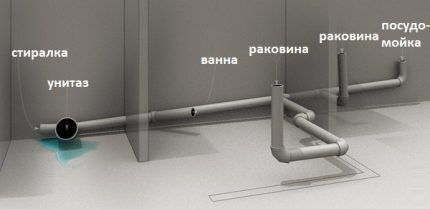
Stage No. 3 - installation of a septic tank
If you decide to make a sewerage system in a private house with your own hands, then it is better to install a septic tank made of concrete rings or a ready-made plastic tank.
The volume of the container for collecting and settling organic waste is determined by calculation. Be sure to add an extra cube. The pipe insertion point is located at a distance of 2/3 from the top edge of the septic tank, so it is not filled to the top.
Construction of a septic tank
The first step is to dig three holes for installing containers. To save time and financial costs, it is advisable to combine two settling tanks into one.
The bottom of the dug hole should be reinforced with a concrete base. Concrete cannot be placed on the ground, so add a layer of crushed stone 20 cm thick.
To construct the base, formwork from construction boards is installed. It must be secured with reinforcement along the outer and inner perimeter.
Use the same mixture composition as for pouring the foundation. In this case, be sure to lay a knitted mesh as a reinforcing element. It is better to take M500 grade cement, since the weight of the filled container will be large.
After the base has hardened, and this will not happen earlier than after 3 weeks, proceed to installing the drives.
Using a crane, they install the concrete rings. When the first link is laid, the joint with the base must be coated with cement mortar or tile adhesive. This way you will achieve tightness.

Do the same with subsequent rings. Before installing the second and third, first apply a layer of mortar to the joints. After installing all the links, re-process the joints inside the container. When the tank is installed, a brick partition is made inside.
Mounted for cleaning inspection hatches. The horizontal partition is made of a concrete slab with holes for plastic covers.
The last step is treatment with waterproofing compound all internal surfaces of two containers.
It is worth keeping in mind that the outlet from the first container should be 10 cm lower than the first - the entrance from the house.
The angle of inclination is determined by the same parameters as for home wiring: with a pipe diameter of 110 mm, the height difference per 1 m is 20 mm.
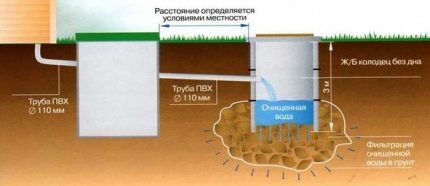
To ensure that the slope of the pipe complies with the standards, the inlet of the second settling tank is lowered by 10 cm relative to the first.
Insulation is attached to the top of the tanks, as well as to the inside of the cleaning hatches. Cleanout or inspection hatches are installed directly above the overflow pipes so that they can be cleaned.
For installation of a drainage well no concrete foundation is required.Here the soil under the rings should allow water to pass through and retain sewage.
Therefore, a sand-crushed stone cushion is poured onto the bottom of the pit. The thicker the layer of crushed stone, the longer the well will perform its functions. After 5 years, you will have to replace the top layer of crushed stone with a new one, because the old one will silt up.
Keep an eye on the level. When installing the first ring on crushed stone, one edge may become warped. If this happens, simply lift the link with a crane and level the level with crushed stone.
The joints of the rings must be treated with a solution to achieve a tight seal. The construction of waterproofing and an inspection hatch is similar to a sump.
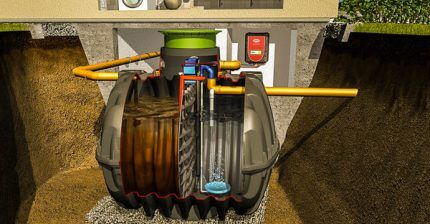
Organization of septic tank ventilation
Installation of ventilation pipes for septic tanks is justified only if aerobic bacteria are used. They intensively absorb air supplied through the hood.
Another type of biological bacteria are anaerobes. Their life processes take place without oxygen.
It is important not to confuse these two concepts, since some anaerobes die if there is air in the environment.
Added to settling tanks aerobes and anaerobes. Bacteria completely convert organic matter into water. In practice, this effect can only be achieved by installing complex filtration systems, but they still need to be used. Therefore, install a ventilation pipe in both sumps.
PVC sewer pipe for outdoor use is discharged from each container through a lid. A deflector is installed at the end.
Stage No. 4 - laying the central pipe
The sewer pipe, which removes sewage from the house, is diverted from the base to a distance of 5 m.The piping for outdoor use is orange. This product differs from “home” pipes in having thicker walls. The permissible laying depth is 3 m.

A layer of sand of 8-10 cm is poured onto the bottom of the dug hole, as well as on top of the laid pipe. To ensure the best removal of organic waste from the house to the septic tank tanks, the pipe should run in one line. Turns of the central drain are strictly prohibited.
Alternatives to a drainage septic tank
A modern device that allows you to purify wastewater by 90% or more is a deep cleaning station.
Biological filtration devices are equipped with three degrees of purification$
- biological treatment with bacteria;
- mechanical filtration with meshes;
- final cleaning with chemical compounds.
It will not be possible to install such a sewer system on your own. The stations are produced in a single container, divided internally into several compartments. The device is volatile.
The compressor unit pumps air into the aerobic compartment for increased bacterial activity. Percentage of water purification, depending on septic tank models, reaches more than 90%.
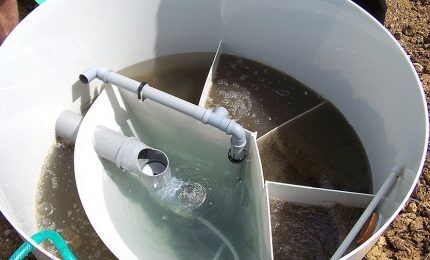
Deep purification of organic matter allows you to use waste water for watering plants. For this purpose, a storage tank with a pump is installed.
It is advisable to use deep treatment stations when groundwater is located too close to the surface of the earth. Also, if the site has clay soil, natural drainage will be difficult.
In addition to a biological septic tank, a sealed tank can serve as a way out of the situation. It will have to be pumped out often, but you won't have any other problems.
Conclusions and useful video on the topic
The intricacies of sewerage installation are outlined by the author of the video, who is busy laying sewer pipes:
The construction of a septic tank made of concrete rings will be discussed in the following video:
Installing a sewer system in a private house is an important stage of construction. Even at the design stage, the owner should think about the future design of septic tanks, their location, as well as the filtration system.
The comfort of everyone living in the house will depend on the correct arrangement of the sewer system, therefore, if you have doubts about your abilities, it is better to entrust its arrangement to specialists.
Do you have personal experience in designing and installing sewerage systems in a country house? Do you want to share your accumulated knowledge or ask questions on the topic? Please leave comments and participate in discussions - the feedback form is located below.




For some reason, in our area there are many village sewage options (like cesspools, etc.), the houses are all private. Yes, it’s cheap and doesn’t require special knowledge, but it’s still much safer to build a normal sewer system with a biological treatment station, rather than calling in sewer trucks every time. Of course, if something happens, you can dig another “waste place”, but this is not always convenient.
Educational and interesting information. I didn’t even know that after deep biological treatment in a septic tank, you can water your plants using water that has been used and freed from organic matter. And all you need for this is a pump with a container for waste water. Moreover, it can be cleaned up to 90%. Although you probably can’t water cultivated plants, herbs, cucumbers, etc. with it.
When organizing a sewer system, I recommend that, in addition to competent design, you carefully choose the manufacturer of pipes and fittings. For example, Hemkor. The price is not much different from the same Ostendorf, but the quality is worth it.
Sewage is a serious thing. It will flood, it won’t seem so small. There are 4 - 5 manufacturers recommended here. I immediately refused to take cheap options. There are only a couple left to choose from: Ostendorf and Hemkor. In general, I took Hemkor. The plumbers said - well done.
By the way, we asked ourselves the same question - what to choose? Ostendorf or Hemkor. Again they decided in favor of Hemkor. They outweighed the arguments of the builders, I don’t remember which ones exactly, but they sounded very impressive. Although the choice of pipes today is simply huge.